Introduction
The publication of Malling Olsen and Larsson's “Gulls of Europe, Asia and North America” in 2003 makes available much of the twenty years of research and understanding that has followed Peter Grant's ground-breaking book, “Gulls, A Guide to Identification” (Grant, 1982, 1986).
It provides new benchmarks and criteria, answers many questions (allowing new ones to be asked), and additionally demands significant revision of our online paper, “The Herring Gull Assemblage in South Korea” (Moores, 2003).
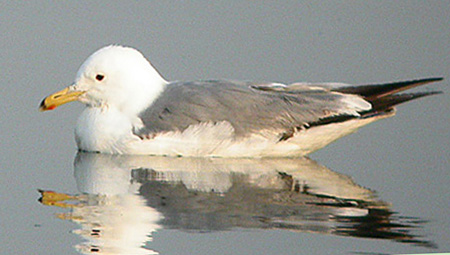
This section aims, based largely on descriptions in Malling Olsen and Larsson (2003), and to a lesser extent on those in Garner (1997) (the latter based "primarily on a visit to the United Arab Emirates and gulls watched there in late February/early March 1996"), to offer a revised appraisal of the potential identification criteria for the highly enigmatic Steppe Gull barabensis in South Korea – a taxon yet to be claimed here formally. It has benefited greatly in the draft stages by input from Dave Sargeant in Oman, from Martin Garner, and by other experienced gullers including Werner Suter, Jochen Roeder, and Neil Davidson in Osaka, Japan.
Comparing descriptions of barabensis with images of taimyrensis, mongolicus and gulls of unknown provenance taken in South Korea, the note is written to encourage observers to share opinions and their images, in order to push forward our understanding of these extremely challenging taxa.
This note will be followed later by further revisions to the sections on Mongolian, Vega and taimyrensis/heuglini Gulls.
What is barabensis?
Before considering the identification and the possible occurrence of barabensis in South Korea, it is first clearly essential to ask a much more fundamental question: what is barabensis?

January 18th 2002, Jeju Island, © Kim Hyun-Tae
In South Korea, the majority of taimyrensis appear more lightly built than vegae, with obviously darker saddles. Head streaking in winter is invariably extensive (and retained in most individuals into April), and typically eyes are pale. By early spring, the vast majority of adult-type taimyrensis show strong yellow tones to the legs. Adult vegae of eastern populations are invariably pink-legged, show darkish, dull, "cloudy" grey saddles, and often appear rather big-headed and proportionately a little short-billed. In winter the head appears rather mottled (rather than finely streaked), with most showing at least some marks still on the nape and neck sides into late March and early April..
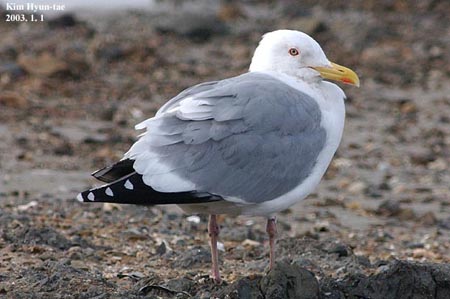
Note the very bulky and powerful look of this individual, not unusual in this taxon. Even in mid-winter some individuals can be (completely) white-headed, while the vast majority of mongolicus in Korea appear obviously paler-and more cleanly grey-saddled than either vegae or taimyrensis.
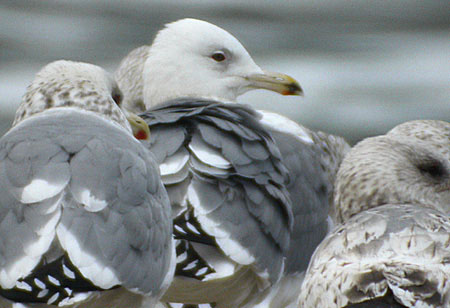
March 8th 2003, Guryongpo, © Nial Moores
Barabensis is the name given to the dark-saddled, often (but not invariably) yellow-legged adult gulls that occur geographically between heuglini to the north, cachinnans to the west, and mongolicus to the east. While Garner (1997) suggests barabensis (as Baraba Yellow-legged Gull) should be regarded as Larus (cachinnans/armenicus) barabensis, Malling Olsen and Larsson (2003) - from hereon referred to as “Gulls” - includes barabensis within Caspian Gull Larus cachinnans, describing it as “‘Steppe Gull’ Larus (cachinnans) barabensis”.
"Gulls" maps barabensis as breeding in the South-east Urals south to North Kazakhstan, with its main wintering area in the Persian Gulf and Oman, and lesser concentrations eastward (adding that it also even “may reach Hong Kong” at this time). Considering its suggested ‘in-between’ range, it might not be surprising that it shares many features with both cachinnans (including to some extent structure and plumage) and heuglini (yellow-leg colour prevalent in adults, plumage, and perhaps most especially rapid moult progression).
However, “Gulls” suggests that on average (1) it is rather more lightly-built than either nominate cachinnans or heuglini; (2) it has a moult timing falling between these other taxa; and (3) it often shows bill patterning more suggestive of Armenian Gull Larus armenicus than either. Additionally, it remains very largely white-headed in mid-winter as an adult – a feature much more typical of the southern rather than the more northern-nesting “Herring Gull Assemblage” taxa, including heuglini.
“Gulls” therefore includes barabensis as a subspecies of Caspian Gull, while adding:
“This distinct taxon has been considered a taxon of either (1) Caspian Gull (Johansen 1960) or (2) Heuglin’s Gull, as a southern representative of Heuglin’s taimyrensis, having developed as a result of introgression by nominate cachinnans genes into Heuglin’s Gull…At MtDNA level not genetically different from Heuglin’s Gull … Area of overlap with Heuglin’s and nominate cachinnans unknown…”
Within even this single paragraph it becomes evident that despite great advances since Grant in the 1980’s, still very little is actually known about barabensis.
In “Gulls”, taimyrensis is itself considered likely the product of hybridization between heuglini and vegae, so according to the second theory cited above, barabensis appears to have been born out of hybridization between both cachinnans and heuglini and heuglini and vegae! If this really is the case, it might seem somewhat surprising both that (a) barabensis remains identical at the mtDNA level to heuglini (unless perhaps some populations of cachinnans and taimyrensis are also similarly identical?) and (b) that it can be described as, and appears to be, a “distinct taxon”.
One of two very similar birds present in the same mixed flock, note the combination of structure, with rounded head and slender bill; bill coloration, with obvious dark markings; dark-looking grey eyes; dark saddle coloration (darker than vegae to left and right and similar to Slaty-backed Gull Larus schistisagus behind it); and white-headedness when most taimyrensis still show extensive head-streaking. A barabensis or an intergrade?


March 9th 2005, Guryongpo, with vegae (rear). © Nial Moores.
This individual was not only structurally very different from the vegae next to it (especially with its almost grotesque Slender-billed Gull Larus genei type bill), but also showed a subtly different shade of grey in the upperparts - paler and cleaner. Believed also too pale and too long-billed for a barabensis, it was also obviously unlike a mongolicus. Reviewing the images and based on extensive experience in Oman, this individual can apparently be considered a "typical cachinnans". (Dave Sargeant, in lit., 2005).
The lack of white primary tips, the dark tail and bill markings and the completely white head, in an otherwise adult-type bird, seem to suggest that it is a rather advanced Third-summer type.
With this “clear-as-mud” background to relationships between taxa to the north and west, “Gulls” avoids discussing in detail the relationship between barabensis and mongolicus to the east - even though both are contained by the authors within Caspian Gull. This is perhaps as mongolicus is thought by “Gulls” (and many others) to be close to Vega Gull Larus vegae, even being considered by Yesou (2002) to belong to it.
However, the most recent analysis apparently reveals that although mongolicus is contained within the same clade as vegae, it is in fact genetically related most closely not to Vega Gull, but instead to the marine-preferential Slaty-backed Gull Larus schistisagus (go to: /Birds/Miscellaneous/BK-BM-DNA-Herring-Gull.shtml).
Additionally, from a Korean perspective, mongolicus also appears rather distinct from vegae, and in many ways closer to nominate Caspian Gull.
For example, the First-winter plumages of both mongolicus and nominate cachinanns can appear rather similar; the bare parts coloration largely overlaps (most especially in regard to leg colour); and adults of both cachinnans and mongolicus remain largely white-headed in winter (unlike vegae and all/most schistisagus). An additional (and as yet untested) element of interest too, is that (many) mongolicus appear to resemble barabensis and heuglini in maturing more rapidly than most other large gulls. Based on personal field observations in Korea, some at least appear to moult from Juvenile into First-winter plumage in July-August of the first calendar year, and then advance, in the second calendar year, more or less directly to a Second-winter plumage that is largely adult-looking (major differences from adults being some retained and worn coverts, extensive dark on the tail and extensive dark bill markings on an otherwise near-adult bill).
(Tentative) Identification of an extralimital barabensis
As many birders are fully aware, “The Herring Gull Assemblage” collectively provides one of the greatest identification challenges.
This is because the Assemblage contains many extremely similar and often still poorly-understood taxa, some of which are suspected of occasional or frequent hybridization. A significant percentage of individuals are therefore best left unidentified on present knowledge, while field identification of an even greater percentage of individuals at the taxon level needs to be both presumptive (rather than definite), and to be based on a combination of a number of features. These features, while often overlapping between adjacent taxa, fortunately tend on average to be rather more prevalent in one population/one taxon than in another. They include structure (and hence behavior and to some extent habitat choice); saddle darkeness/paleness in adults; bare parts coloration; white-headedness or streak-headedness in non-breeding adults; primary pattern; timing of moult; and in juveniles and immature plumages, details of the e.g. wing coverts, scapulars, mantle, tertials and tail.
Of course, average differences/consistency in these features often become quite apparent in flocks of the same taxon, but they are much harder to determine when observing potentially out-of-range individuals of little-known taxa.
In the case of barabensis, as noted above, much still remains confused, and despite the detailed plates and lengthy descriptions given in “Gulls”, all are presented there with the rather understated caveat:
“It should be noted that the full range of ID features between barabensis and eastern cachinnans as well as from paler Heuglin’s Gull ‘taimyrensis’ is not fully understood.”
In this ‘understanding’ it is surely still very valuable to summarise some key features of barabensis as described in “Gulls” (for much greater detail, please refer to “Gulls” itself), and in Garner (1997), and then to relate these features to taimyrensis, “dark” Mongolian Gulls and some further selected individuals of unclear provenance observed in South Korea.
To assist and narrow down the discussion, it is first worth noting that, prior to this note, the only taxa of the Herring Gull Assemblage to be adequately documented in South Korea have been: American Herring Gull Larus smithsonianus; Vega Gull Larus vegae vegae and Larus vegae birulai; Heuglin’s Gull Larus heuglini taimyrensis (with nominate heuglini also suspected to occur); and Mongolian Gull Larus (cachinnans) mongolicus (see: Birds Korea: Status and Distribution of Gulls in Korea).
Mongolian Gull is believed to be the only member of the Herring Gull Assemblage to be at all regular in Korea in the summer months (May-early September), and up to the present, extreme dates of darker-mantled, yellow-legged individuals of this Assemblage (i.e. taimyrensis or barabensis) have fallen between mid-September in autumn and the second week of May in spring.
Considering this absence of records of yellow-legged, dark-mantled gulls in the summer, it can be presumed that if adult barabensis does occur in South Korea, then they are most are likely to do so largely in the non-breeding season (e.g. October-April). During most of that period, adults of both American and Vega Gull are heavily streak-headed (and also show obviously pink-toned legs). The major identification challenge in Korea, therefore can be expected to come from separating potential adult barabensis from similar-aged heuglini/taimyrensis, from some "forms" of Mongolian Gull, and also perhaps from individuals of the even more westerly-distributed Caspian Gull Larus c. cachinnans (see e.g. Figs 5 and 6).
Juvenile and First-winter barabensis are also considered by “Gulls” very close in appearance to Juvenile and First-winter heuglini and cachinnans, and thus should be relatively easy to separate from both smithsonianus and vegae at this age on a range of features (for further information, please refer both to “Gulls” and to: http://www.birdskorea.org//Birds/Identification/ID_Notes/BK-ID-Herring-Gull-Page1.shtml). The following section therefore focuses on differences between barabensis, taimyrensis and mongolicus (the latter two taxa based significantly on personal observations) and nominate heuglini and to a rather less extent, cachinnans (based very much on “Gulls”).
Structure
According to "Gulls", barabensis is on average slightly smaller and lighter than both nominate cachinnans and heuglini, with heuglini also considered to be "smaller" on average than taimyrensis.
Note, however, that many birds identified as taimyrensis in South Korea likely appear significantly different to birds identified as heuglini and taimyrensis in the Middle East. For example, Sargeant (in lit., 2005) commented of birds in Oman that even "heuglini here are larger (than barabensis), with relatively more massive heads and bills - they look ferocious", while most taimyrensis (now generally considered to be larger than heuglini, contra Grant 1986) still appear in Korea rather more gentle-looking, and less bulky than for example either vegae or mongolicus.
Barabensis typically has a rounded look to the head (rather squarer in taimyrensis in Korea), a still flattish forehead (though considered to have a "steep forehead, unlike nominate cachinnans" by Garner, 1997), small eyes, and a slightly shorter, narrower bill and shorter legs than either. Garner adds that barabensis sometimes has a "very thin" bill; that some individuals are "noticeably flat-chested and slender", and that some are "more stocky, but often with a ’straight’ deep, flat chest profile"; that the back "looks very flat with no tertial step; primary projection looks shorter and less attenuated than on nominate cachinnans and taimyrensis.The legs are rather short, noticeably so on some individuals, especially compared with the leggy, sloping-backed cachinnans. Overall the appearance recalls Common or Iceland Gull at times" (Garner, 1997).
Although there is near complete overlap between heuglini and barabensis in the measurements given in “Gulls” (with only an obvious difference between e.g. larger heuglini and smaller barabensis), the range of weights presented indicates a quite significant difference at the extremes, with nominate cachinnans weighing between 680 and 1 500 grams, heuglini weighing between 745 and 1300 grams and barabensis between only 680 and 1 170 grams. This compares to a weight of between 850 and 1 590 grams for mongolicus, and suggests that very large and heavily-built individuals are unlikely to be barabensis.
Adult
Adult barabensis has dark grey upperparts (i.e. mantle, scapulars and wings), similar to taimyrensis according to “Gulls” - but perhaps appearing rather obviously darker-grey than many, based on a comparison of the plates in “Gulls” with taimyrensis seen in Korea. It is thus also rather darker than most mongolicus (apart from North-western populations perhaps?) and darker than western cachinnans.
Additionally, according to "Gulls" this upperpart grey often shows more of a brownish cast than that in heuglini, while the head and underparts, according to Dave Sargeant (in lit, 2005) appear "very white" and "seem to shine in good light", similar to many mongolicus in Korea, and dissimilar from most taimyrensis (pers obs.) Although much of the plumage is shared with adult heuglini, it also tends often to show a more poorly-marked tertial step and scapular crescent.

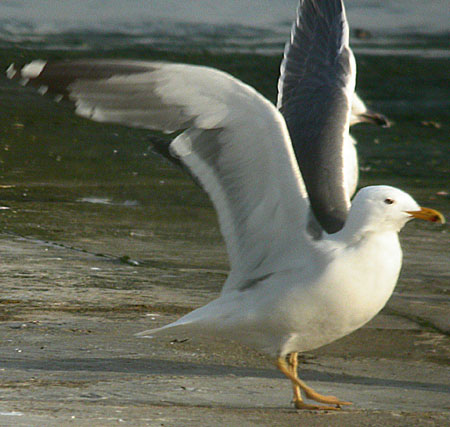
April 21st 2005, Eocheong Island. © Nial Moores
This very short-legged and rather small individual, considered after review of the images to be a “classic barabensis" (Garner, in lit., 2005: see comments) was contained in a group of ca 14 presumed taimyrensis and one further putative barabensis, to which it displayed, with head-raising and protracted calls.
This and the other individual both showed a round-headed look, very bright bare parts coloration, bills with variable but rather extensive dark markings, and completely unstreaked heads (while all/most individuals identified as taimyrensis still showed faint streaking at close range). The view of the underwing reveals extensive black in the outer primaries and mirrors in both P 10 and P 9, with the mirrors perhaps appearing slightly larger in the images than in the field due to blurring from movement.
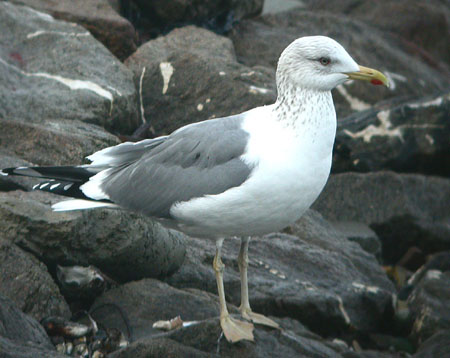
"Typical" Adult taimyrensis. Note the slate-grey upperparts; the streaked head (densest on the hind-neck), even in late March; the pale eye; and the rather uniformly patterned bill, with the red gonys spot reaching at least to the cutting edge. Of relevance to the discussion on separation of taimyrensis from barabensis, Dave Sargeant commented of this individual (in lit., 2005) that he had "never seen one like this in the Middle East".

This rather powerfully-built individual showed extensive head-streaking typical of taimyrensis in April, but atypically showed a small dark mark adjacent to the gonys spot and rather grayish eyes. By mid-April, most taimyrensis have rather brighter bare parts coloration than typical of mid-winter.
Unlike heuglini, cachinnans or mongolicus, it also has an often four-coloured bill (bright yellow, with black subterminal band, red gonys spot, and paler tip). In flight, adult barabensis show rather solid black wing tips, with black markings on the primaries often reaching Primary 3 (P3), or at least P4, and a small mirror on P10 (and sometimes P9). More western cachinnans show less solidly black wing-tips, often with black markings only to P5, more obvious “white tongues”, and often a white tip to P10, while this patterning, “Gulls” states, increasingly starts to overlap with barabensis eastward. mongolicus shows considerable variation, with a few showing black markings to P4, others only to P5; some with an obvious white tip to P10, and others with mirrors on P10, or P 9 and P10. Heuglini usually, like barabensis, show only a small mirror on P10, and dark markings to P4, but many taimyrensis (the form of heuglini considered to occur regularly in Korea) show more obvious mirrors, very often on P9 and P10. In this way, many adult barabensis should appear more solidly black on the wing-tip than most similar-sized gulls, with typically one or sometimes two small mirrors.
Adult: Breeding Plumage (March-September)
According to Garner (1997), the bare parts of barabensis are "often brightest of all forms" (i.e. than heuglini/taimyrensis and nominate and ponticus cachinnans), while "Gulls" states that many barabensis also show four-coloured bills in breeding plumage (though this does not seem to be well-supported by the photographs in the same book).
Although breeding-plumaged mongolicus (January/February-August) sometimes shows a paler bill tip, most full adults typically lack strong dark bill markings in summer, with only weak markings often confined to the upper mandible. The barabensis bill pattern is also different from that of adult summer heuglini (April-October), which is described by “Gulls” as being very similar to Lesser Black-backed Gull Larus fuscus graellsii i.e. yellow-orange with red gonys spot and no obvious dark markings, and no obvious paler tip. The legs of breeding-plumaged barabensis range from often bright yellow in more northern areas to sometimes grey or fleshy in the south of its range, while most heuglini appear bright and yellow-legged, and most taimyrensis by April at least are also obviously yellow-legged. Mongolicus shows great variation, but the majority in Korea appear pink, grey-pink or rarely yellowy-pink, in e.g. April (with only a few more blue-grey mantled individuals, probably mongolicus, showing more obviously yellowish legs). The eyes of barabensis often appear dark. Heuglini, by contrast, usually appears pale-eyed, with apparently less than 10% with spotting dark enough to create the impression of a darker-looking iris “at distance”. In taimyrensis, the iris is “pale yellow, rarely dark (intergrades with nominate?)” (“Gulls”), and the vast majority of birds seen in Korea and Japan by the author are obviously pale-eyed.
Mongolicus shows variable iris colour, with some appearing pale or peppered, and some darker-mantled birds especially perhaps appearing more solidly dark-eyed.
Adult: Winter (September-March)
Non-breeding adult barabensis show narrow and faint brown hindneck streaks, with the rest of the head effectively clean white, but already with "all birds bright white-headed in late February, unlike heuglini/taimyrensis" (Garner, 1997).
Adult mongolicus appear largely white-headed between August and March, with in many faint to coarse hind-neck streaks (rather denser and perhaps more extensive in a very small percentage - these apparently more frequent in birds on the Korean east coast than on the west coast), while according to “Gulls” nominate cachinnans shows streaks largely confined to the nape. Heuglini and taimyrensis, on the other hand, show rather extensive head-streaking.
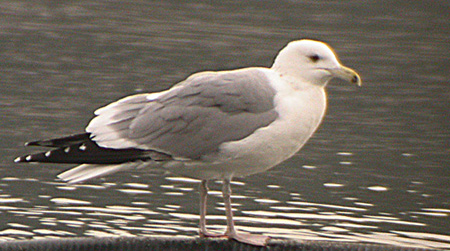
Largely white-headed (with only faint hindneck-streaking) this rather large and aggressive individual had a darker saddle than several vegae in direct comparison, and extensive dark bill markings.

January 6th 2005, Jumunjin. © Nial Moores
Very dark saddled, yellowish-legged and largely white-headed (with only faint hind-nape streaking), this individual was also obviously dark-eyed. Other images reveal that it had apparently completed its primary moult, unlike the taimyrensis next to it. Rather round-headed, it showed only faint dark markings on the bill, above the rather prominent gonys spot. A dark Mongolian, an intergrade, or even possibly an eastern cachinnans or barabensis?
Many taimyrensis in South Korea show an obvious dark patch around the eye, weak streaks on the crown, and brownish smudges or finer streaks sometimes extending onto the breast sides. Personal experience of taimyrensis in Korea also suggests that the vast majority have obvious head (especially hind-neck) streaking between October and mid-April.
On March 24th 2005, for example, of ca 40 adult taimyrensis-types (all yellow-legged and dark grey mantled) seen at medium range in one flock by NM at Saemangeum, all but two showed obvious head-streaking. Of these two, one still showed reduced faint streaks on the nape, while the other appeared completely white-headed and also round-headed, and showed very obvious dark markings on the bill. This latter individual was thus considered to be a putative barabensis. By April 20th 2005, at least three-quarters of ca 15 adult taimyrensis seen on nearby Eocheong Island showed either reasonably extensive or rather faint streaking (the latter typically confined to the nape), still detectable at moderate range.
“Gulls” concurs that taimyrensis typically retains this extensive head streaking at least until March, when barabensis should be largely white-headed. Many barabensis in non-breeding plumage still have a four-coloured bill (though paler-looking overall than breeding-plumaged birds, as are the eyes), while most fully adult mongolicus show variable but often weak dark bill markings, often with a slightly paler bill tip, and often with rather pale eyes. Again, very occasionally darker individuals occur, often with darker bill markings and darker eyes (could these possibly be intergrades between mongolicus and eastern cachinnans or barabensis, if such intergrades occur?).
Nominate cachinnans show “slight dark subterminal markings” to the bill, and often “darkish-looking eyes”, while taimyrensis typically have pale eyes, and bills with small dark subterminal markings, and distinctively an orangey-red gonys spot, bleeding up onto the upper mandible.
Juveniles to First-winters to Second-winters to Adults
“Gulls” provides much detailed explanation of plumage minutiae, and timing of moult which is considered so important in supporting the separation of e.g. juvenile heuglini from the extremely similar barabensis, with heuglini for example moulting into First-winter in mid-winter (from December to March), barabensis moulting rather earlier (October to March) and mongolicus, based on personal observations, typically moulting from Juvenile into First-winter earlier still (often from July or August).
In First-winter, western-type cachinnans (September-April) settled birds are often described as being four-toned, with white heads and underparts; brownish looking wing coverts; a grayish, dark-patterned mantle; and blackish primaries (and bill). In flight, First-winter cachinnans typically also show a fairly narrow tail band, a variegated wing-tip and a weak pale blaze on the inner primaries. Due to contrasting tips and bases in the greater coverts and secondaries, they usually show two dark and two pale wing-bars.

Note the fresh look to the largely juvenile plumage, even in mid-January, and the structure: neat, but not especially round-headed, lacking an especially long-forehead or slender bill.
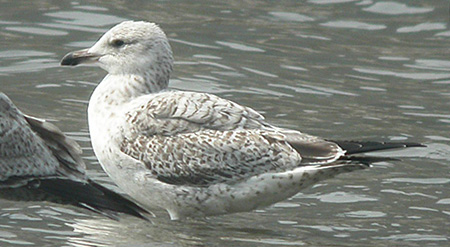
Standing to the right of a First-winter Slaty-backed Gull, this individual still shows fairly extensive streaking on the crown and hind-nape, and has not yet started to show any of the darker adult-type feathers perhaps expected of a “first-summer” heuglini or barabensis gull by this date.
(NB: Confident identification of this individual from mongolicus or vegae was supported by good flight views).
This patterning is largely shared by barabensis, though it is said to often retain rather more dark markings on the head and underparts and to show a less contrasting appearance than nominate cachinnans. It is described as “never as pale and four-coloured as Western cachinnans” (“Gulls”). Although also extremely similar, First-winter heuglini, is described by “Gulls” thus:
“head whitish with narrow brown streaks on crown and ear coverts (often creating dark mask) and broad/dark spots/streaks on hindneck, sides of neck and breast…Underbody and flanks often densely dark-spotted…Mantle and scapulars grayish-brown with distinct black sub-terminal markings…many retain most juvenile upperparts and moult directly to adult-type mantle, scapulars and usually coverts”.
Based on personal observations of taimyrensis, many appear fairly similar to the description and plates of heuglini in “Gulls”, while others tend to show e.g. rather more obviously bleached or spotty greater coverts (a product of either hybridization with vegae or subspecific difference). mongolicus (First-winter from August onwards) can also appear rather similar, though structurally the majority appear rather more massive and deep-chested. When settled, the saddle of First-winters also appears typically pale grey with rows of blackish bars (or anchors), and in flight, apart from the blackish secondary bar, the upperwings appear rather pale and less contrasting (especially as often rather worn by mid-winter), with the paler-still inner primaries showing obvious dark sub-terminal hook-shaped marks (“dark golf-clubs”). Most individuals also show frayed tertials by mid- or late-winter, when many presumed taimyrensis and presumably babarensis are still in largely juvenile and comparatively fresh-looking plumage. Other observers suggest, however, that occasionally mongolicus remain in juvenile plumage into the late winter and also can appear fresh-looking at this time.

Even by late December this rather typical individual is largely white-headed, has pale-greyish feathering on the mantle and scapulars (with obvious dark subterminal marks) and appears rather worn.
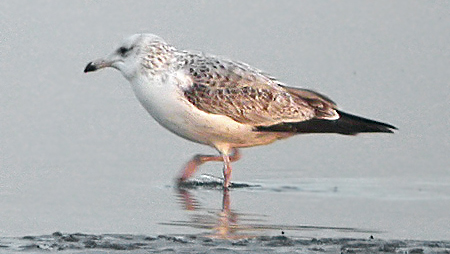
Although gulls show great variation, this bird appears both structurally and plumage-wise very different from taimyrensis or mongolicus, and also rather different from (images of) western cachinnans. Despite its rather long forehead, could this be a barabensis gull?
“Gulls” outlines the progress of moult of heuglini and barabensis as being very rapid, with First-winters effectively moulting directly into a Second-winter plumage that appears rather adult-like. As noted above, this moult progression might well be shared by some/many mongolicus. In the case of Second-winter plumages, the dark-grey adult-type saddle coloration should rule out most mongolicus, and the paler bill tip in barabensis might prove a useful feature to separate it from heuglini.
Summary of Identification Features
Based on the description of adults in “Gulls” and in Garner (1997), and following input from Dave Sargeant, an individual adult large gull in South Korea in winter (November-March) showing all or most of the following features might well be best considered as a putative barabensis:
Rather slender-looking and lightly built (though more heavily-built individuals also likely), lacking obvious tertial step;
Head appearing rather rounded-looking;
Very bright bare parts coloration (especially from e.g. February);
Yellow legs (though grayish, pinkish legs also likely), sometimes shortish-looking;
Often slender-looking bill;
Bill often with distinctive four-coloured pattern, with red gonys, black subterminal markings and pale tip (though some of pattern sometimes lacking);
Darkish-looking rather small eyes (though paler-eyed birds possible);
Dark grey upperparts, with perhaps in some a brownish cast;
Clean and reflective white underparts and head;
Head-streaking, if present, confined to the nape;
Extensive black in the primaries in flight.
Features better suited for taimyrensis include:
Neat, but not especially slender structure. Head lacking long forehead but bill not especially slender or parallel-sided;
Dark grey upperparts, without any brownish cast;
Pale eyes;
Orangey-yellow bill with gonys spot bleeding up on to the upper mandible, and no obvious dark markings or pale tip;
Streaking extensive on the head and breast sides;
Obvious mirrors on P 10 and P 9, with limited solid black in the spread wing.
Juveniles, and most especially, First-winter barabensis, might be claimable on the tendency to be in a more advanced state of moult, and in the case of separation from taimyrensis, by appearing especially white-headed or having a bill with extensive pink basally earlier in the winter/spring. Second-winters and Third-winters also might be considered on structure, bill pattern and perhaps brownish cast to the upperparts.
The Status of barabensis in South Korea
Considering all of the above, and the dearth of reliable identification criteria until very recently, there have been no documented records of either barabensis (or nominate cachinnans) in South Korea.
However, individuals that perhaps appear to match descriptions of barabensis rather better than taimyrensis or mongolicus seem to occur each winter, with for example probably ca 10 such individuals noted by NM between January and April 2005.
This compares to peak day counts of ca 100 taimyrensis (with higher numbers most especially in October-November and again in March and April), and day counts of several tens to several thousands of mongolicus (especially in March in the far northwest).
At best, barabensis is therefore likely a very scarce winter visitor to South Korea.
Some Putative barabensis gulls in Korea (2005)
The following section contains basic descriptions and images of four individual putative barabensis gulls (comprising three records) seen by NM and other observers in 2005.
We would, as always, greatly appreciate relevant images for use, as well as further well-considered feedback - for inclusion in comments below, and for revising this online paper.
Two adults, Seosan, January 25th
(both seen with Gruff and Sara Dodd, Kingsley and Sharon Parker, and Clive and Eleanor Hurley). Fig. 17: Adult, January 25th 2005, Seosan, Nial Moores
Fig. 17: Adult, January 25th 2005, Seosan, Nial MooresFirst (Figure 17, right) was seen in very dull light, swimming. Appeared rather round-headed, and slender, with a medium-long bill lacking an obvious hook at the tip, or pronounced gonydeal angle. Wing projection beyond the tail appeared to be similar to or very slightly longer than the distance between the longest tertial and the tail tip. Additionally, showed no obvious sign of primary moult when settled. Nape was streaked with fine brown, but head appeared otherwise clean white. In direct comparison with Black-tailed Gull Larus crassirostris, appeared only medium sized (i.e. smaller than many Mongolian Gull), with the dark upperparts a similar shade of grey (i.e. darker than all but a very few Mongolian Gull). The legs were seen only briefly, but appeared yellow-toned or yellow-tinged. The bill was distinctly four-coloured, with obvious dark markings and pale tip. Eye appeared very small and darkish or at least bi-coloured. Not seen in flight.
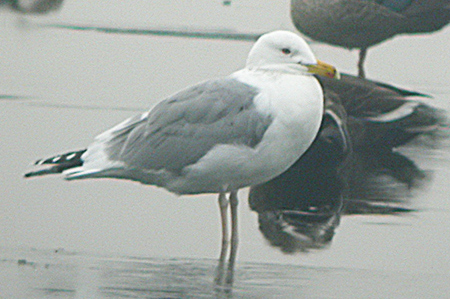 Fig. 18: Adult barabensis-type, January 25th 2005, Seosan, Nial Moores
Fig. 18: Adult barabensis-type, January 25th 2005, Seosan, Nial MooresThe second individual (Figure 18, right) was watched resting and preening, ca 3 Km distant from the first. This individual looked rather bulky, approaching some Mongolian Gull in structure, though with rather rounded head-shape with full nape. Wing projection beyond the tail was similar to the length between the longest tertial and tail tip, with fresh-looking primary tips and no obvious primary moult. The underside of the primaries on the furthest wing showed a pattern very similar to that of barabensis shown in “Gulls” (First Edition, plate 466), with an obvious long white mirror, separated by a band of black from the white tip. The head appeared clean white, with only very faint traces of streaking to the rear of the nape. The upperparts were slightly paler grey than the first bird (though still darker than several other Mongolian Gull in direct comparison; similar to many taimyrensis and vegae). The legs appeared yellowish in the field (not apparent in the image). The eye was obviously bi-colored. The bill appeared reasonably heavy, though lacked an obvious gonydeal angle or hook, and showed a very distinctive four-colour pattern, with an obvious gonys spot, dark band extending from the gonys up across the upper mandible, and an obviously ivory tip. Is this “barabensis-pattern” also shown by some Mongolian Gull?
First-winter/(First-summer), March 3rd, Song Do (with Werner Suter et al). Same as Fig. 16 above.
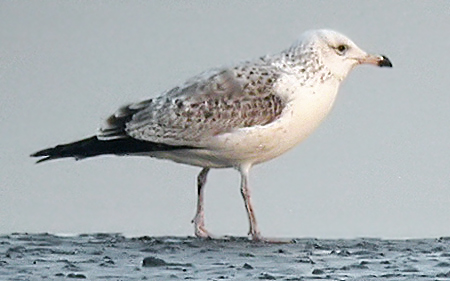 Fig. 19: First-winter gull, March 3rd 2005, Song Do, Incheon, Nial Moores
Fig. 19: First-winter gull, March 3rd 2005, Song Do, Incheon, Nial MooresThis individual was watched in good light, and appeared unlike most taimyrensis. It seemed rather advanced (considering the date), with a largely white-headed look, some darker grayer feathers mixed in the upperparts and in the coverts (“Gulls” states of barabensis: “In first winter often moult mantle, scapulars, and many coverts…These parts may, however, also be moulted into grey with faint subterminal markings or barred type (probably when moulted in autumn…))”, and an obviously pink-based bill.
It also showed a rather obvious white eye-ring and the feathering extending much more obviously on the upper than the lower mandible (which seems also to be a feature of so-called “Yellow Sea Gulls”, a very poorly documented type, in some ways perhaps suggesting barabensis in showing a dark grey mantle, often yellowish legs and largely white-head in winter).
March 4th, Third-winter into Third-summer, Seosan (with Werner Suter et al.)
 Fig. 20: Third winter/summer putative barabensis,
Fig. 20: Third winter/summer putative barabensis,
March 4th 2005, Seosan (same as Fig 1), Nial MooresWatched in very good light, this individual was aged by a combination of lack of white primary tips, dark markings on the tail, and otherwise near-adult appearance. It appeared rather round-headed, and slender, lacked an obvious tertial step, and showed wing extension beyond the tail rather greater than the distance between the tip of the lowest tertial and the tail tip. Its head was completely unstreaked (thus unlike the vast majority of taimyrensis at this time), and its eye appeared small and also very dark (also highly atypical for taimyrensis). Its leg colour, seen poorly as the bird swam, was yellow. The upperparts were a very dark grey (similar to Black-tailed Gull), with a slight brownish cast (perhaps because the plumage appeared rather worn?). The bill was three- or four-coloured, being rather bright yellow (with a faintly greener tone), with a strong gonys spot confined obviously to the lower mandible), an obvious, incomplete black band, and at some angles a slightly paler tip.
Summary
The “Herring Gull Assemblage” presents one of the greatest identification challenges. The publication of “Gulls” (made available after our draft paper on the Assemblage was put online) presents much improved identification criteria for many taxa, including the highly enigmatic barabensis “Steppe Gull” – a taxon as yet not formally recorded in South Korea.
This online paper summarises many of the criteria for barabensis detailed in “Gulls”, comparing them with taimyrensis, dark Mongolian Gull and other individuals of unknown provenance seen and photographed in South Korea.
The comparison suggests that lightly built, darkish-mantled adult gulls with dark eyes and strongly patterned bills might well be identifiable as barabensis (or at least “barabensis-types”); and that some individuals of other age-groups might also be recognizable. It also suggests that at least some individuals apparently matching barabensis rather better than taimyrensis or mongolicus do occur in South Korea with some regularity in winter, with perhaps 10 or so seen by the author in early 2005 alone.
Acknowledgements
Nial and Charlie Moores wish to thank Dave Sargeant and Martin Garner for commenting on specific images; KIM Hyun Tae for the use of his excellent images; Werner Suter for advice on specific individuals and for kindly photocopying and mailing on Martin Garner’s 1997 paper on Large White-headed Gulls; Jochen Roeder for very kindly supplying his images of cachinnans for comparison; and to Neil Davidson for providing many images and much discussion on birds seen in Osaka.
To keep the length of this note down, we have reproduced some of these comments on a separate page: please go to Steppe Gull barabensis in South Korea - Comments.
References
- Garner, M. (1977). Large White-headed Gulls in the United Arab Emirates. A contribution to their field identification. Emirates Bird Report: 19. pp. 94-103.
- Grant, P. (1986). Gulls. A Guide to Identification. T & AD Poyser.
- Malling Olsen, K. & H. Larsson (2003). Gulls of Europe, Asia and North America. Published by Helm.
- Yésou, P. (2002). Systematics of Larus argentatus-cachinnans-fuscus complex revisited. Dutch Birding 24 (5): 271-298.
Online Paper
Moores N. (2003) A Consideration of the Herring Gull Assemblage in South Korea (edited by C. Moores). Go to Birds Korea: Large White-headed Gulls.
See also:



